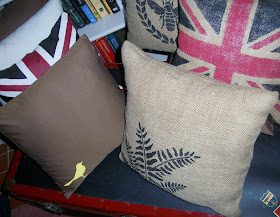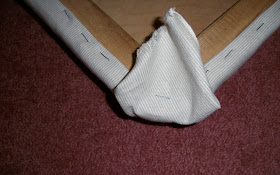I'm selling pillows as I make them for now...the fair is still a while away. So, these could be yours for $15 each! I can also do custom pillows for between $15-$25 depending on fabric and graphic.
Huzzah!
Want to hear a little trivia about me, and the time I was a real, live elf in the North Pole? Unlike 'Law & Order', this story totally depicts a real, live person. Me!
My middle name is Fay (as in the 'Fay' from 'Fay Grayson Home.' Yeah, that's me). According to the irrefutable website The Free Dictionary, 'Fay' or 'Fey' means the following:
Word History: The history of the words
fey and fay illustrates a rather fey coincidence. Our word
fay, "fairy, elf," the descendant of Middle English faie, "a
person or place possessed of magical properties," and first recorded around
1390, goes back to Old French fae, "fairy," the same word that has given
us fairy.
So 'Fay' means elf, obviously.
Then you've got the 'Emily' part. Would you believe that the Latin, French, America, German, and Teutonic (basically Germanic peoples) meaning of the name 'Emily' is 'industrious' or 'hard-working?' No? Check it out:
Teutonic Meaning: The name Emily is a Teutonic baby name. In Teutonic the meaning of the name Emily is: From the Roman family name Aemilius, meaning 'industrious.' Also a From the Old German Amalburga, meaning labour and the Latin Aemilia.
American Meaning:
The name Emily is an American baby name. In American the meaning of the name Emily is: Hard working.
The name Emily is an American baby name. In American the meaning of the name Emily is: Hard working.
French Meaning:
The name Emily is a French baby name. In French the meaning of the name Emily is: Hard working.
The name Emily is a French baby name. In French the meaning of the name Emily is: Hard working.
German Meaning:
The name Emily is a German baby name. In German the meaning of the name Emily is: Industrious. From the Roman family name Aemilius. Famous bearer: French writer Emile Zola.
The name Emily is a German baby name. In German the meaning of the name Emily is: Industrious. From the Roman family name Aemilius. Famous bearer: French writer Emile Zola.
Latin Meaning:
The name Emily is a Latin baby name. In Latin the meaning of the name Emily is: Industrious; striving. From the name Aemilia, the feminine form of the Roman family name Aemilius.
The name Emily is a Latin baby name. In Latin the meaning of the name Emily is: Industrious; striving. From the name Aemilia, the feminine form of the Roman family name Aemilius.
Emily + Fay = Industrious, hardworking elf.
(FYI: this is the limit to which my math skills can be stretched)
(FYI: this is the limit to which my math skills can be stretched)
Have I told you about the time I lived in Qikiqtarjuaq, Nunavut...which is, basically, to round up, the North Pole of Canada?
Oh! Oh! And check out this extra little chestnut which I have no idea how they could come up with, because it doesn't describe me at all. Pffft. Pop-sci (or whatever).
"People with this name tend to initiate events, to be leaders rather than followers, with powerful personalities. They tend to be focused on specific goals, experience a wealth of creative new ideas, and have the ability to implement these ideas with efficiency and determination. They tend to be courageous and sometimes aggressive. As unique, creative individuals, they tend to resent authority, and are sometimes stubborn, proud, and impatient."
Honestly, people, I can't make this stuff up.
True story.







































